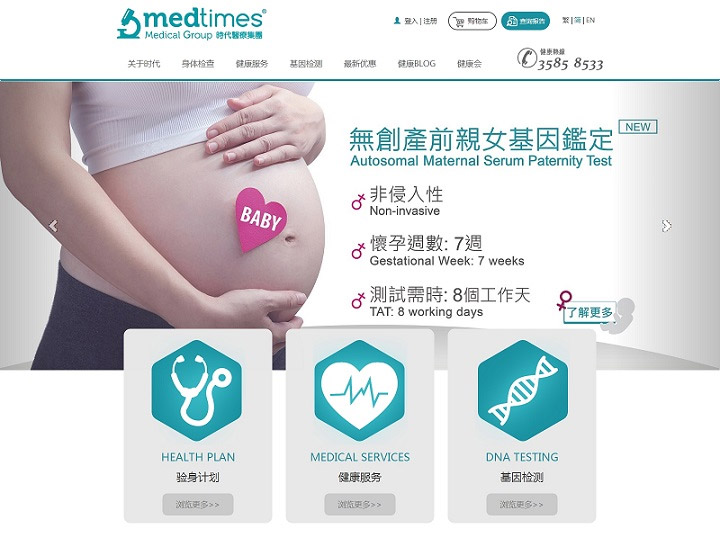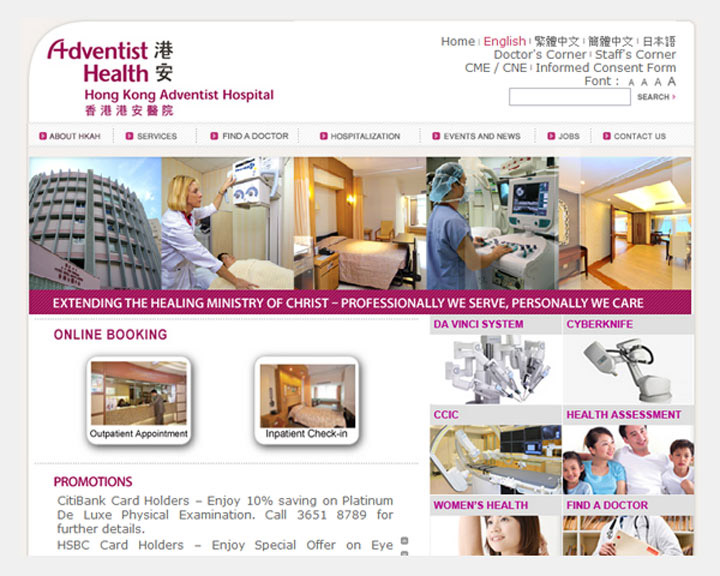- 首頁
- Blog
- How to Design a Clinic Website? A Comprehensive Guide to Enhancing Patient Conversion from Visuals to Marketing
How to Design a Clinic Website? A Comprehensive Guide to Enhancing Patient Conversion from Visuals to Marketing
2025 / 10 / 31
In Hong Kong's highly competitive private healthcare market, for an ordinary private clinic to break through the barriers established by large conglomerates and steadily gain a foothold, it's not enough to just have qualified medical staff and technology. A professional and trustworthy website is essential to enhance brand image and directly drive appointment conversion rates.
In this article, Arachne Group Limited will delve into "how to design a clinic website" from the perspectives of visual design, online marketing strategy, and boosting appointment conversion, enabling your website to deliver its intended value!

Traditionally, clinic websites were often used merely to display basic contact information and services. However, with changing patient behavior, a clinic's website has long surpassed its role as an "online business card" and become a core channel for attracting clients, building trust, and facilitating conversions.
Unfortunately, many clinic owners remain at the stage of thinking "having a website is enough," without exploring the strategic value of website design, leading to:
Severe Lack of Credibility and Professionalism
When potential patients learn about your clinic through personal recommendations or online searches, they often first search for the clinic's name online. If the clinic lacks an official website and only has a sparse Google Business Profile or information on third-party platforms, they are likely to turn to competitors with professional websites.
Information Chaos and Inefficiency
Specifically, details such as services offered, physician expertise, operating hours, appointment methods, parking information, and closure notices are crucial information patients need. Without a website, clinics must rely on staff repeatedly answering the same questions over the phone or posting fragmented information on Google Business Profile or social media, leading to inconsistencies. This not only significantly increases communication costs but may also cause disputes due to miscommunication.
Ineffective Online Reputation Management and Accumulation
While Google Business Profile can accumulate reviews, a dedicated brand website offers more robust functionality. It can proactively showcase positive patient testimonials and, when negative reviews appear elsewhere, allow for professional and sincere explanations or clarifications, demonstrating a responsible attitude rather than passive reaction.
Insufficient Competitiveness and Marginalization in the Digital Wave
When all surrounding clinics, even newly opened ones, possess aesthetically pleasing and fully-functional websites, your clinic will inevitably appear outdated compared to peers, making it difficult to stand out. This is especially true when trying to attract younger, digitally-native demographics, where competitiveness is almost nonexistent.
Missing a Key Tool for Integrating Appointments and Services
Modern patients increasingly prefer online booking to avoid the inconvenience of phone waits. A professional website can integrate an "Online Booking System," allowing patients to make appointments 24/7. Lacking this functionality equates to turning away patients accustomed to digital services, potentially leading them directly to other clinics.

Thus, a website is not just an online display window for a clinic; it is a critical platform for creating a professional, trustworthy first impression instantly and guiding visitors to become loyal patients. Therefore, clinic website design must not only accurately convey relevant service information but also be strategic:
Website Visual Design: Crafting a Professional and Trustworthy First Impression
Visual design is the first point of contact for patients; it must convey a sense of professionalism, reassurance, and warmth within seconds, making patients feel the clinic's reliability and care even before stepping inside.
Professional and Clean Overall Style
Color Scheme: Primary colors are recommended to be cool tones like blue and green, which convey stability, safety, and health, fostering psychological trust. Accent colors like white and light gray can create a sense of cleanliness, while warm orange or yellow can be used for call-to-action buttons to increase approachability and guide action.
Layout & Typography: Overly flashy layouts distract patients. Website design should adhere to the "simplicity" principle, ensuring ample whitespace to make key information stand out and reduce reading pressure. Maintain consistency from font choices to layout structure, allowing users to easily understand the site's logic and find information quickly.
High-Quality Imagery: This is key to enhancing website quality. Avoid clichéd, low-resolution stock photos. Use genuine photos of the clinic environment—bright, tidy waiting areas, and treatment room equipment—to familiarize patients and reduce apprehension. Professional team photos are essential: doctors and staff in professional attire (e.g., lab coats), with natural, confident portraits. Warm, smiling team photos significantly boost patient trust.Where possible, consider warm treatment scenario photos (with patient consent or professional staging) to showcase positive patient interactions.
Clear and Understandable Information Architecture
Main Navigation: Should be simple and clear. Key items include: "Home, About Us, Services, Medical Team, Book Appointment, Health Education, Contact Us." These cover the essential information patients seek.
Homepage Structure: As the website's summary, the homepage should function like a refined brochure, clearly presenting from top to bottom: the clinic's core value/key services, medical team introduction, key service highlights, booking methods, latest news/health articles, and contact information with an embedded map. This layout lets patients grasp key info immediately, sparking interest.
Three-Click Rule: Ensure users can find any information within three clicks. For example, a patient wanting to book a teeth whitening service should follow: "Services -> Teeth Whitening -> Book Now Button," streamlining the process and preventing frustration.
Fully Responsive Design
Over half of web traffic comes from mobiles and tablets. The website must display perfectly and operate smoothly on all devices. Buttons should be sized for easy finger tapping, and text should be easily readable without zooming, ensuring a consistent, high-quality experience.
Search Engine Optimization (SEO) – The Foundation of Passive Lead Generation
Local SEO: This is crucial, the lifeline for clinic websites. Ensure your Google Business Profile is complete with address, phone, hours, services, and photos. Encourage satisfied patients to leave positive reviews to boost search ranking and trust.
Keyword Strategy: Target service keywords (e.g., "dental implants," "invisible aligners," "pediatric dentistry," "dermatology clinic"), location keywords (e.g., "Central Hong Kong dentist recommendation," "Causeway Bay orthodontic specialist"), and long-tail keywords (e.g., "what to do for sensitive teeth," "acne-prone skin care clinic") which, while lower volume, target users with specific queries.
Content Marketing (Health Education): Regularly publish high-quality health articles or videos. This addresses common patient questions, establishes authority, and is ideal for ranking for long-tail keywords (e.g., "What are the signs of gum disease? Five symptoms not to ignore").
Content is King: Establishing Professional Authority
Blog/Resource Section: Share knowledge on diseases, treatment processes, post-operative care, and health news. Consistent, valuable content attracts patients and builds professional credibility.
Case Studies (Handle with Care): With full patient authorization and privacy protection, showcase before-and-after results (e.g., orthodontics, skin treatments). This visually demonstrates effectiveness, building confidence.
Doctor Interview Videos: Short videos where doctors explain expertise, treatment philosophy, or answer FAQs can quickly build rapport and trust.
Social Media Integration and Retargeting
Integration: Include links to official Line, Facebook, and Instagram accounts on the website for interaction. Use Line@ or Official Account features for a "one-click add friend" button, facilitating easy booking, inquiries, and receiving updates.
Retargeting Ads: Install Facebook Pixel or Google Tag. Run retargeting ads to users who visited the website but didn't book, reminding them to schedule an appointment, thereby increasing conversion.
Boosting Appointment Conversion: The Final Nudge from Visitor to Patient
Increasing appointment conversion is the website's ultimate goal, achieved by guiding users through design and copywriting.
Clear and Repeated Calls-to-Action (CTAs)
Visibility: The "Book Appointment" button must be clear on every page, typically in the top-right corner or fixed at the bottom. Use high-contrast colors (e.g., red button on white background).
Strategic Placement: Place booking buttons or contact info after service descriptions, below doctor profiles, and at the end of articles, giving users multiple opportunities to convert.
Compelling Copy: Use action-oriented text like "Book Now," "Online Consultation," or "Appointment Hotline" instead of passive phrases like "Contact Us" to create urgency.
Lowering Barriers and Alleviating Concerns
Multiple Booking Channels: Offer options like "Online Form," "Phone Booking," and "WhatsApp Booking" to suit different preferences.
Simplified Online Forms: Only ask for essential info: Name, Phone, Desired Service, Preferred Time. Fewer fields reduce abandonment rates. Complex questions can be handled via phone confirmation.
Trust Elements: Display doctor qualifications, professional memberships, Google/Facebook 5-star reviews, professional equipment, sterilization processes, and awards to build confidence and alleviate doubts.
Addressing Frequently Asked Questions (FAQs)
Have a dedicated FAQ section answering questions like "Fee Structure?", "What to prepare for the first visit?", or "Which department for shingles?", reducing hesitation.
Clearly display clinic address, phone number, and business hours in the header/footer, embedding a Google Map for easy location finding.
Technical Optimization for Enhanced Experience
Website Speed: Slow loading times cause users to leave. Optimize images and use efficient web hosting to ensure fast performance.
SSL Certificate: A basic security requirement. The "https://" and lock icon in the address bar encrypt patient data, enhancing trust.
An outstanding clinic website is the perfect blend of professional image, patient experience, and marketing conversion. As a leading web design company in Hong Kong, Arachne Group Limited understands the specific needs of the healthcare industry. We tailor professional and efficient website solutions for clinics, helping attract more ideal patients and boost business performance. Contact us today for a custom website design proposal and consultation!
In this article, Arachne Group Limited will delve into "how to design a clinic website" from the perspectives of visual design, online marketing strategy, and boosting appointment conversion, enabling your website to deliver its intended value!
Why Does Every Ordinary Private Clinic Need a Website? The Website's Role Extends Beyond Being an "Online Business Card"

Traditionally, clinic websites were often used merely to display basic contact information and services. However, with changing patient behavior, a clinic's website has long surpassed its role as an "online business card" and become a core channel for attracting clients, building trust, and facilitating conversions.
Unfortunately, many clinic owners remain at the stage of thinking "having a website is enough," without exploring the strategic value of website design, leading to:
Severe Lack of Credibility and Professionalism
When potential patients learn about your clinic through personal recommendations or online searches, they often first search for the clinic's name online. If the clinic lacks an official website and only has a sparse Google Business Profile or information on third-party platforms, they are likely to turn to competitors with professional websites.
Information Chaos and Inefficiency
Specifically, details such as services offered, physician expertise, operating hours, appointment methods, parking information, and closure notices are crucial information patients need. Without a website, clinics must rely on staff repeatedly answering the same questions over the phone or posting fragmented information on Google Business Profile or social media, leading to inconsistencies. This not only significantly increases communication costs but may also cause disputes due to miscommunication.
Ineffective Online Reputation Management and Accumulation
While Google Business Profile can accumulate reviews, a dedicated brand website offers more robust functionality. It can proactively showcase positive patient testimonials and, when negative reviews appear elsewhere, allow for professional and sincere explanations or clarifications, demonstrating a responsible attitude rather than passive reaction.
Insufficient Competitiveness and Marginalization in the Digital Wave
When all surrounding clinics, even newly opened ones, possess aesthetically pleasing and fully-functional websites, your clinic will inevitably appear outdated compared to peers, making it difficult to stand out. This is especially true when trying to attract younger, digitally-native demographics, where competitiveness is almost nonexistent.
Missing a Key Tool for Integrating Appointments and Services
Modern patients increasingly prefer online booking to avoid the inconvenience of phone waits. A professional website can integrate an "Online Booking System," allowing patients to make appointments 24/7. Lacking this functionality equates to turning away patients accustomed to digital services, potentially leading them directly to other clinics.
How to Design a Clinic Website? Enhancing Patient Conversion from Visuals to Marketing

Thus, a website is not just an online display window for a clinic; it is a critical platform for creating a professional, trustworthy first impression instantly and guiding visitors to become loyal patients. Therefore, clinic website design must not only accurately convey relevant service information but also be strategic:
Website Visual Design: Crafting a Professional and Trustworthy First Impression
Visual design is the first point of contact for patients; it must convey a sense of professionalism, reassurance, and warmth within seconds, making patients feel the clinic's reliability and care even before stepping inside.
Professional and Clean Overall Style
Color Scheme: Primary colors are recommended to be cool tones like blue and green, which convey stability, safety, and health, fostering psychological trust. Accent colors like white and light gray can create a sense of cleanliness, while warm orange or yellow can be used for call-to-action buttons to increase approachability and guide action.
Layout & Typography: Overly flashy layouts distract patients. Website design should adhere to the "simplicity" principle, ensuring ample whitespace to make key information stand out and reduce reading pressure. Maintain consistency from font choices to layout structure, allowing users to easily understand the site's logic and find information quickly.
High-Quality Imagery: This is key to enhancing website quality. Avoid clichéd, low-resolution stock photos. Use genuine photos of the clinic environment—bright, tidy waiting areas, and treatment room equipment—to familiarize patients and reduce apprehension. Professional team photos are essential: doctors and staff in professional attire (e.g., lab coats), with natural, confident portraits. Warm, smiling team photos significantly boost patient trust.Where possible, consider warm treatment scenario photos (with patient consent or professional staging) to showcase positive patient interactions.
Clear and Understandable Information Architecture
Main Navigation: Should be simple and clear. Key items include: "Home, About Us, Services, Medical Team, Book Appointment, Health Education, Contact Us." These cover the essential information patients seek.
Homepage Structure: As the website's summary, the homepage should function like a refined brochure, clearly presenting from top to bottom: the clinic's core value/key services, medical team introduction, key service highlights, booking methods, latest news/health articles, and contact information with an embedded map. This layout lets patients grasp key info immediately, sparking interest.
Three-Click Rule: Ensure users can find any information within three clicks. For example, a patient wanting to book a teeth whitening service should follow: "Services -> Teeth Whitening -> Book Now Button," streamlining the process and preventing frustration.
Fully Responsive Design
Over half of web traffic comes from mobiles and tablets. The website must display perfectly and operate smoothly on all devices. Buttons should be sized for easy finger tapping, and text should be easily readable without zooming, ensuring a consistent, high-quality experience.
Online Marketing Strategy: Helping Target Patients Find and Trust You
Once the website is live, the core goal of online marketing is to make it discoverable by patients in need and convert them into potential clients.Search Engine Optimization (SEO) – The Foundation of Passive Lead Generation
Local SEO: This is crucial, the lifeline for clinic websites. Ensure your Google Business Profile is complete with address, phone, hours, services, and photos. Encourage satisfied patients to leave positive reviews to boost search ranking and trust.
Keyword Strategy: Target service keywords (e.g., "dental implants," "invisible aligners," "pediatric dentistry," "dermatology clinic"), location keywords (e.g., "Central Hong Kong dentist recommendation," "Causeway Bay orthodontic specialist"), and long-tail keywords (e.g., "what to do for sensitive teeth," "acne-prone skin care clinic") which, while lower volume, target users with specific queries.
Content Marketing (Health Education): Regularly publish high-quality health articles or videos. This addresses common patient questions, establishes authority, and is ideal for ranking for long-tail keywords (e.g., "What are the signs of gum disease? Five symptoms not to ignore").
Content is King: Establishing Professional Authority
Blog/Resource Section: Share knowledge on diseases, treatment processes, post-operative care, and health news. Consistent, valuable content attracts patients and builds professional credibility.
Case Studies (Handle with Care): With full patient authorization and privacy protection, showcase before-and-after results (e.g., orthodontics, skin treatments). This visually demonstrates effectiveness, building confidence.
Doctor Interview Videos: Short videos where doctors explain expertise, treatment philosophy, or answer FAQs can quickly build rapport and trust.
Social Media Integration and Retargeting
Integration: Include links to official Line, Facebook, and Instagram accounts on the website for interaction. Use Line@ or Official Account features for a "one-click add friend" button, facilitating easy booking, inquiries, and receiving updates.
Retargeting Ads: Install Facebook Pixel or Google Tag. Run retargeting ads to users who visited the website but didn't book, reminding them to schedule an appointment, thereby increasing conversion.
Boosting Appointment Conversion: The Final Nudge from Visitor to Patient
Increasing appointment conversion is the website's ultimate goal, achieved by guiding users through design and copywriting.
Clear and Repeated Calls-to-Action (CTAs)
Visibility: The "Book Appointment" button must be clear on every page, typically in the top-right corner or fixed at the bottom. Use high-contrast colors (e.g., red button on white background).
Strategic Placement: Place booking buttons or contact info after service descriptions, below doctor profiles, and at the end of articles, giving users multiple opportunities to convert.
Compelling Copy: Use action-oriented text like "Book Now," "Online Consultation," or "Appointment Hotline" instead of passive phrases like "Contact Us" to create urgency.
Lowering Barriers and Alleviating Concerns
Multiple Booking Channels: Offer options like "Online Form," "Phone Booking," and "WhatsApp Booking" to suit different preferences.
Simplified Online Forms: Only ask for essential info: Name, Phone, Desired Service, Preferred Time. Fewer fields reduce abandonment rates. Complex questions can be handled via phone confirmation.
Trust Elements: Display doctor qualifications, professional memberships, Google/Facebook 5-star reviews, professional equipment, sterilization processes, and awards to build confidence and alleviate doubts.
Addressing Frequently Asked Questions (FAQs)
Have a dedicated FAQ section answering questions like "Fee Structure?", "What to prepare for the first visit?", or "Which department for shingles?", reducing hesitation.
Clearly display clinic address, phone number, and business hours in the header/footer, embedding a Google Map for easy location finding.
Technical Optimization for Enhanced Experience
Website Speed: Slow loading times cause users to leave. Optimize images and use efficient web hosting to ensure fast performance.
SSL Certificate: A basic security requirement. The "https://" and lock icon in the address bar encrypt patient data, enhancing trust.
An outstanding clinic website is the perfect blend of professional image, patient experience, and marketing conversion. As a leading web design company in Hong Kong, Arachne Group Limited understands the specific needs of the healthcare industry. We tailor professional and efficient website solutions for clinics, helping attract more ideal patients and boost business performance. Contact us today for a custom website design proposal and consultation!
MORE BLOG
-
What Functions Does an Online Store Design Typically Include? Five Essential Core Functions, Each Indispensable!
2025/12/10 The following will guide you step-by-step from fundamental concepts to essential practical functions, and then to payment gateway options and advanced integrations, to master everything you need to know about building a successful online store. -
Do Individual Studios Need a Website? Sharing Five Key Areas of Web Development and Online Promotion Focus
2025/12/03 This requires entrepreneurs to consider creating a professional website and developing an effective online promotion strategy to ensure their individual studio stands out in a competitive market. -
Web Development + Digital Marketing: Crafting Thanksgiving & Black Friday Campaigns That Drive Record Profits for Businesses
2025/11/21 As your professional partner in web development and digital marketing, Arachne Group Limited understands that a successful holiday campaign is far more than just offering "discounts."
















